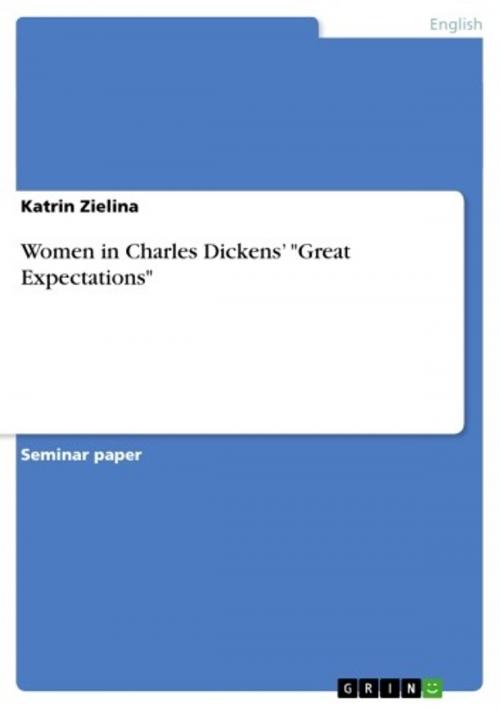Women in Charles Dickens' 'Great Expectations'
Fiction & Literature, Literary Theory & Criticism, British| Author: | Katrin Zielina | ISBN: | 9783638275217 |
| Publisher: | GRIN Verlag | Publication: | May 10, 2004 |
| Imprint: | GRIN Verlag | Language: | English |
| Author: | Katrin Zielina |
| ISBN: | 9783638275217 |
| Publisher: | GRIN Verlag |
| Publication: | May 10, 2004 |
| Imprint: | GRIN Verlag |
| Language: | English |
Seminar paper from the year 2003 in the subject English Language and Literature Studies - Literature, grade: 2 (B), University of Frankfurt (Main) (Institute for England - und American Studies), course: Charles Dickens - Great Expectatoins, language: English, abstract: 1. Introduction Charles Dickens' novel 'Great Expectations' as a Bildungsroman or gothic novel depicts the growth of a young boy from low social class origin to an adult gentleman containing the struggles with women, employers and relatives. The main character Philip 'Pip' Pirrip introduces the reader to the novel as a young boy from about six years, although Pip indeed wrote down the story of his life as an adult. Pip has always dreamt of becoming well-educated and of being introduced to a higher social class than he actually belonged to at first. Fortunately, Pip is granted the chance of social rising and he gets to know a lot of people who influence him and his great expectations from his early youth crucially. In Victorian times women and men were regarded to be different in their nature but never-theless complementary. Women should be a guideline for their husbands in moral and reli-gious questions. When the husbands were at home they were protected from 'destructive tendencies of the market' (Farrell). In 'Great Expectations' it is not easy to find one woman who fits into this ideal. Especially the three main female characters are rather de-structive than protective for men. However, throughout the novel Pip is confronted with several women of different calibre, from shrewd and hysterical, cold-hearted and distant to caring and loveable. On the follow-ing pages I am going to introduce and characterise the three main female characters who influence Pip's life the most: his sister Mrs. Joe Gargery, Mrs. Havisham and Estella. Of course Pip gets to know more women, but since they play only a more or less minor role in his life, I am not going to put them under consideration. After having described and char-acterised the three women, I am going to analyse their relationship towards Pip and in the end come to a final conclusion. 2. Characterisation of three main female characters
Seminar paper from the year 2003 in the subject English Language and Literature Studies - Literature, grade: 2 (B), University of Frankfurt (Main) (Institute for England - und American Studies), course: Charles Dickens - Great Expectatoins, language: English, abstract: 1. Introduction Charles Dickens' novel 'Great Expectations' as a Bildungsroman or gothic novel depicts the growth of a young boy from low social class origin to an adult gentleman containing the struggles with women, employers and relatives. The main character Philip 'Pip' Pirrip introduces the reader to the novel as a young boy from about six years, although Pip indeed wrote down the story of his life as an adult. Pip has always dreamt of becoming well-educated and of being introduced to a higher social class than he actually belonged to at first. Fortunately, Pip is granted the chance of social rising and he gets to know a lot of people who influence him and his great expectations from his early youth crucially. In Victorian times women and men were regarded to be different in their nature but never-theless complementary. Women should be a guideline for their husbands in moral and reli-gious questions. When the husbands were at home they were protected from 'destructive tendencies of the market' (Farrell). In 'Great Expectations' it is not easy to find one woman who fits into this ideal. Especially the three main female characters are rather de-structive than protective for men. However, throughout the novel Pip is confronted with several women of different calibre, from shrewd and hysterical, cold-hearted and distant to caring and loveable. On the follow-ing pages I am going to introduce and characterise the three main female characters who influence Pip's life the most: his sister Mrs. Joe Gargery, Mrs. Havisham and Estella. Of course Pip gets to know more women, but since they play only a more or less minor role in his life, I am not going to put them under consideration. After having described and char-acterised the three women, I am going to analyse their relationship towards Pip and in the end come to a final conclusion. 2. Characterisation of three main female characters















